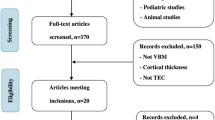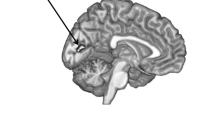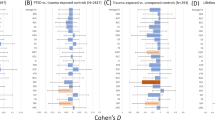Abstract
A number of MRI studies have shown focal or diffuse cortical gray matter (GM) abnormalities in patients with post-traumatic stress disorder (PTSD). However, the results of these studies are unclear regarding the cortical regions involved in this condition, perhaps due to the heterogeneity of the PTSD population included or to the differences in the methodology used for the quantification of the brain structures. In this study, we assessed differences in cortical GM volumes between a selected group of 25 drug-naive PTSD patients with history of adulthood trauma and 25 matched non-traumatized controls. Analyses were performed by using two different automated methods: the structural image evaluation using normalization of atrophy (SIENAX) and the voxel-based morphometry (VBM), as we trusted that if these complementary techniques provided similar results, it would increase the confidence in the validity of the assessment. Results of SIENAX and VBM analyses similarly showed that cortical GM volume decreases in PTSD patients when compared to healthy controls, particularly in the frontal and occipital lobes. These decreases seem to correlate with clinical measures. Our findings suggest that in drug-naïve PTSD patients with a history of adulthood trauma, brain structural damage is diffuse, with a particular prevalence for the frontal and occipital lobes, and is clinically relevant.


Similar content being viewed by others
References
Lindauer RJ, Vlieger EJ, Jalink M, Olff M, Carlier IV, Majoie CB, den Heeten GL, Gersons BP (2004) Smaller hippocampal volume in Dutch police officers with posttraumatic stress disorder. Biol Psychiatry 56:356–363
Wignall EL, Dickson JM, Vaughan P, Farrow TFD, Wilkinson ID, Hunter MD, Woodruff PWR (2004) Smaller hippocampal volume in patients with recent-onset posttraumatic stress disorder. Biol Psychiatry 56:832–836
Corbo V, Clement MH, Armony JL, Pruessner JC, Brunet A (2005) Size versus shape differences: contrasting voxel-based and volumetric analyses of the anterior cingulate cortex in individuals with acute posttraumatic stress disorder. Biol Psychiatry 58:119–124
Woodward SH, Kaloupek DG, Streeter CC, Martinez C, Schaer M, Eliez S (2005) Decreased anterior cingulate volume in combat-relate PTSD. Biol Psychiatry 59:582–587
Karl A, Schaefer M, Malta LS, Dörfel D, Rohleder N, Werner A (2006) A meta-analysis of structural brain abnormalities in PTSD. Neurosci Biobehav Rev 30:1004–1031
Chen S, Xia W, Li L, Liu J, He Z, Zhang Z, Yan L, Zhang J, Hu D (2006) Gray matter density reduction in the insula in fire survivors with posttraumatic stress disorder: a voxel-based morphometric study. Psychiatry Res 146:65–72
Kasai K, Yamasue H, Gilbertson MW, Shenton ME, Rauch SL, Pitman RK (2008) Evidence for acquired pregenual anterior cingulate gray matter loss from a twin study of combat-related posttraumatic stress disorder. Biol Psychiatry 63:550–556
Nardo D, Högberg G, Looi JC, Larsson S, Hällström T, Pagani M (2010) Gray matter density in limbic and paralimbic cortices is associated with trauma load and EMDR outcome in PTSD patients. J Psychiatr Res 44:477–485
De Bellis MD, Keshavan NS, Shifflett H, Iyengar S, Beers SR, Hall J, Moritz G (2002) Brain structures in pediatric maltreatment-related posttraumatic stress disorder: a sociodemographically matched study. Biol Psychiatry 52:1066–1078
Carrion VG, Weems CF, Eliez S, Patwardhan A, Brown W, Ray RD, Reiss AL (2002) Attenuation of frontal asymmetry in pediatric posttraumatic stress disorder. Biol Psychiatry 50:943–951
Fennema-Notestine C, Stein MB, Kennedy CM, Archibald SL, Jernigan TL (2002) Brain morphometry in female victims of intimate partner violence with and without posttraumatic stress disorder. Biol Psychiatry 52:1089–1101
Geuze E, Westwenberg HGM, Heinecke A, de Kloet CS, Goebel R, Vermetten E (2008) Thinner prefrontal cortex in veterans with posttraumatic stress disorder. Neuroimage 41:675–681
Bossini L, Tavanti M, Calossi S, Lombardelli A, Polizzotto NR, Galli R, Vatti G, Pieraccini F, Castrogiovanni P (2008) Magnetic resonance imaging volumes of the hippocampus in drug-naïve patients with post-traumatic stress disorder without comorbidity conditions. J Psychiatr Res 42:752–762
Woodward SH, Schaer M, Kaloupek DG, Cediel L, Eliez S (2009) Smaller global and regional cortical volume in combat-related posttraumatic stress disorder. Arch Gen Psychiatry 66:1373–1382
Smith SM, Zhang Y, Jenkinson M, Chen J, Matthews PM, Federico A, De Stefano N (2002) Accurate, robust, and automated longitudinal and cross-sectional brain change analysis. Neuroimage 17:479–489
Ashburner J, Friston JK (2000) Voxel-based morphometry—the methods. Neuroimage 11:805–821
Honea R, Crow TJ, Passingham D, Mackay CE (2005) Regional deficits in brain volume in schizophrenia: a meta-analysis of voxel-based morphometry studies. Am J Psychiatry 162:2233–2245
De Stefano N, Battaglini M, Smith SM (2007) Measuring brain atrophy in multiple sclerosis. J Neuroimaging 17(Suppl 1):10S–15S
First MB, Spitzer RL, Gibbon M, Williams JB (1995) Structured clinical interview for Axis I DSM IV disorders, Non-patient edition (SCID-I/NP, version 2.0). Biometrics Research Department, New York State Psychiatric Institute, New York
Blake DD, Weathers FW, Nagy LM, Kaloupek DG, Gusman FD, Charney DS, Keane TM (1995) The development of a Clinician-Administered PTSD Scale. J Trauma Stress 8:75–90
First MB, Spitzer RL, Gibbon M, Williams JB (1996) Structured clinical interview for Axis I DSM-IV disorders-patient Edition (SCID-I/P, version 2.0). Biometrics Research Department, New York State Psychiatric Institute, New York
First MB, Spitzer RL, Gibbon M, Williams JB (1994) Structured clinical interview for axis II DSM IV disorders (SCID-II/P). Biometrics Research Department, New York State Psychiatric Institute, New York
Hamilton M (1960) A rating scale for depression. J Neurol Neurosurg Psychiatry 23:56–62
Hamilton M (1959) The assessment of anxiety states by rating. Br J Med Psychol 32:50–55
De Stefano N, Matthews PM, Filippi M, Agosta F, De Luca M et al (2003) Evidence of early cortical atrophy in MS. Neurology 60:1157–1162
Mazziotta J, Toga A, Evans A, Fox P, Lancaster J, Zilles K, Woods R, Paus T, Simpson G, Pike B, Holmes C, Collins L, Thompson P, MacDonald D, Iacoboni M, Schormann T, Amunts K, Palomero-Gallagher N, Geyer S, Parsons L, Narr K, Kabani N, Le Goualher G, Boomsms D, Cannon T, Kawashima R, Mazoyer B (2001) A probabilistic atlas and reference system for the human brain: International Consortium for Brain Mapping (ICBM). Philos Trans R Soc Lond B Biol Sci 356:1293–1322
Battaglini M, Smith SM, Brogi S, De Stefano N (2008) Enhanced brain extraction improves the accuracy of brain atrophy estimation. NeuroImage 40:583–589
Battaglini M, Giorgio A, Stromillo ML, Bartolozzi ML, Guidi L et al (2009) Voxel-wise assessment of progression of regional brain atrophy in relapsing–remitting multiple sclerosis. J Neurol Sci 282:55–60
Zhang Y, Brady M, Smith S (2001) Segmentation of brain MR images through a hidden Markov random field model and the expectation maximization algorithm. IEEE Trans Med Imaging 20:45–57
Rueckert D, Sonoda LI, Hayes C, Hill DLG, Leach MO, Hawkes DJ (1999) Non-rigid registration using free-form deformations: Application to breast MR images. IEEE Trans Med Imaging 18:712–721
Good C, Johnsrude I, Ashburner J, Henson R, Friston K, Frackowiak R (2001) A voxel-based morphometric study of ageing in 465 normal adult human brains. Neuroimage 14:21–36
Shapiro SS, Wilk MB (1965) An analysis of variance test for normality (complete samples). Biometrika 52:591–611
Levene H (1960) Robust tests for equality of variances. In: Olkin I, Ghurye SG, Hoeffding W, Madow WG, Mann HB (eds) Contributions to probability and statistics: essays in honor of Harold Hotelling. Stanford University Press, California, pp 278–292
Nichols TE, Holmes AP (2002) Nonparametric permutation tests for functional neuroimaging: a primer with examples. Hum Brain Mapp 15:1–25
Smith SM, Jenkinson M, Woolrich MW, Beckmann CF, Behrens TEJ, Johansen-Berg H, Bannister PR, De Luca M, Drobnjak I, Flitney DE, Niazy RK, Saunders J, Vickers J, Zhang Y, De Stefano N, Brady JM, Matthews PM (2004) Advances in functional and structural MR image analysis and implementation as FSL. Neuroimage 23:208–219
Kessler RC, Berglund P, Demler O, Jin R, Merikangas KR, Walters EE (2005) Lifetime prevalence and age-of-onset distributions of DSM-IV disorders in the national comorbidity survey replication. Am Med Assoc 62:593–602
Kessler RC, Chiu WT, Demler O, Walters EE (2005) Prevalence, severity and comorbidity of 12-month DSM-IV disorders in the national comorbidity survey replication. Am Med Assoc 62:617–627
Bremner JD (2007) Functional neuroimaging in post-traumatic stress disorder. Expert Rev Neurother 7:393–405
Nutt DJ, Malizia AL (2004) Structural and functional brain imaging in posttraumatic stress disorder. J Clin Psychiatry 65:11–17
Nemeroff CB, Bremner JD, Foa EB, Mayberg HS, North CS, Stein MB (2006) Posttraumatic stress disorder: a state-of-the-science review. J Psychiatr Res 40:1–21
Bremner JD, Vythilingam M, Vermetten E, Vaccarino V, Charney DS (2004) Deficits in hippocampal and anterior cingulate functioning during verbal declarative memory encoding in midlife major depression. Am J Psychiatry 161:637–645
Shin LM, Wright CI, Cannistraro PA, Wedig MM, McMullin K, Martis B, Mackiln ML, Lasko NB, Cavanagh SR, Krangel TS, Orr SP, Pitman RK, Whalen PJ, Rauch SL (2005) A functional magnetic resonance imaging study of amygdala and medial prefrontal cortex responses to overtly presented fearful faces in posttraumatic stress disorder. Arch Gen Psychiatry 62:273–281
Geuze E, Westenberg HG, Jochims A, de Kloet CS, Bohus M, Vermetten E, Schmahl C (2007) Altered pain processing in veterans with posttraumatic stress disorder. Arch Gen Psychiatry 64:76–85
Geuze E, Vermetten E, Ruf M, de Kloet CS, Westenberg HG (2008) Neural correlates of associative learning and memory in veterans with posttraumatic stress disorder. J Psychiatr Res 42:659–669
Phelps EA, Delgado MR, Nearing KI, LeDoux JE (2004) Extinction learning in humans: role of the amygdala and vmPFC. Neuron 43:897–905
Amaral DG, Price JL, Pitkanen A, Carmichael ST (1992) Anatomical organization of the primate amygdaloid complex. The amygdala neurobiological aspects of emotion. Memory and mental dysfunction. In: Aggleton W (ed) 1992. Wiley, New York, pp 1–66
Lanius RA, Bluhm R, Pain C (2006) A review of neuroimaging studies in PTSD: heterogeneity of response to symptom provocation. J Psichiatr Res 40:709–729
Hendler T, Rotshtein P, Yeshurun Y, Weizmann T, Kahn I, Ben-Bashat D, Malach R, Bleich A (2003) Sensing the invisible: differential sensitivity of visual cortex and amygdala to traumatic context. Neuroimage 19:587–600
Francati V, Vermetten E, Bremner JD (2007) Functional neuroimaging studies in posttraumatic stress disorder: review of current methods and findings. Depress Anxiety 24:202–218
Lindauer RJ, Booij J, Habraken JB, Uyling HB, Olff M et al (2004) Cerebral blood flow changes during script-driven imagery in police officers with posttraumatic stress disorder. Biol Psychiatry 56:853–861
Yamasue H, Kasai K, Iwanami A, Ohtani T, Yamada H, Abe O, Kuroki N, Fukuda R, Tochigi M, Furukawa S, Sadamatsu M, Sasaki T, Aoki S, Ohtomo K, Asukai N, Kato N (2003) Voxel-based analysis of MRI reveals anterior cingulated gray-matter volume reduction in posttraumatic stress disorder due to terrorism. Proc Natl Acad Sci USA 100:9039–9043
Abe O, Yamuse H, Kasai K, Yamada H, Aoki S, Iwanami A, Ohtani T, Masutani Y, Kato N, Ohtomo K (2006) Voxel-based diffusion tensor analysis reveals aberrant anterior cingulum integrity in posttraumatic stress disorder due to terrorism. Psychiatry Res 146:231–242
McEwen BS (2008) Central effects of stress hormones in health and disease: understanding the protective and damaging effects of stress and stress mediators. Eur J Pharmacol 583:174–185
Yehuda R, Flory JD (2007) Differentiating biological correlates of risk, PTSD, and resilience following trauma exposure. J Trauma Stress 20:435–447
Frangou S, Chitins X, Williams SCR (2004) Mapping IQ and gray matter density in healthy young people. Neuroimage 23:800–805
Lange N, Froimowitz MP, Bigler ED, Lainhart JE et al (2010) Brain Development Cooperative Group. Associations between IQ, total and regional brain volumes, and demography in a large normative sample of healthy children and adolescents. Dev Neuropsychol 35:296–317
McEwen BS (2000) The neurobiology of stress: from serendipity to clinical relevance. Brain Res 886:172–189
Zhang H, Ozbay F, Lappalainen J, Kranzler HR, van Dyck CH, Charney DS, Price LH, Southwick S, Yang BZ, Rasmussen A, Gelernter J (2006) Brain derived neurotrophic factor (BDNF) gene variants and Alzheimer’s disease, affective disorders, posttraumatic stress disorder, schizophrenia, and substance dependence. Am J Med Genet B Neuropsychiatr Genet 141B:387–393
Beng-Choon H, Nancy CA, Jeffrey DD, Thomas HW (2007) Association between brain-derived neurotrophic factor Val66Met gene polymorphism and progressive brain volume changes in schizophrenia. Am J Psychiatry 164:1890–1899
Acknowledgments
The authors wish to thank all the subjects for their participation in the study. Institutional funds of the Department of Neuroscience, University of Siena.
Conflict of interest
All Authors have no biomedical financial or potential conflicts of interest.
Author information
Authors and Affiliations
Corresponding author
Rights and permissions
About this article
Cite this article
Tavanti, M., Battaglini, M., Borgogni, F. et al. Evidence of diffuse damage in frontal and occipital cortex in the brain of patients with post-traumatic stress disorder. Neurol Sci 33, 59–68 (2012). https://doi.org/10.1007/s10072-011-0659-4
Received:
Accepted:
Published:
Issue Date:
DOI: https://doi.org/10.1007/s10072-011-0659-4




